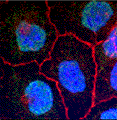Biochemistry, Department of
Document Type
Article
Date of this Version
2007
Citation
The Journal of Biological Chemistry, VOL. 282, NO. 24, pp. 17442–17449, June 15, 2007
Abstract
The hydrogen peroxide sensitivity of cells lacking two proteins,
Sco1 and Cox11, important in the assembly of cytochrome
c oxidase (CcO), is shown to arise from the transient accumulation
of a pro-oxidant heme A-Cox1 stalled intermediate. The
peroxide sensitivity of these cells is abrogated by a reduction in
either Cox1 expression or hemeAformation but exacerbated by
either enhanced Cox1 expression or heme A production arising
from overexpression of COX15. Sco1 and Cox11 are implicated
in the formation of the CuA and CuB sites of CcO, respectively.
The respective wild-type genes suppress the peroxide sensitivities
of sco1∆ and cox11∆ cells, but no cross-complementation is
seen with noncognate genes. Copper-binding mutant alleles of
Sco1 and Cox11 that are nonfunctional in promoting the assembly
of CcO are functional in suppressing the peroxide sensitivity
of their respective null mutants. Likewise, human Sco1 that is
nonfunctional in yeast CcO assembly is able to suppress the peroxide
sensitivity of yeast sco1∆ cells. Thus, a disconnect exists
between the respiratory capacity of cells and hydrogen peroxide
sensitivity. Hydrogen peroxide sensitivity of sco1∆ and cox11∆
cells is abrogated by overexpression of a novel mitochondrial
ATPase Afg1 that promotes the degradation of CcO mitochondrially
encoded subunits. Studies on the hydrogen peroxide sensitivity
in CcO assembly mutants reveal new aspects of the CcO
assembly process.
Included in
Biochemistry Commons, Biotechnology Commons, Other Biochemistry, Biophysics, and Structural Biology Commons



Comments
© 2007 by The American Society for Biochemistry and Molecular Biology, Inc.